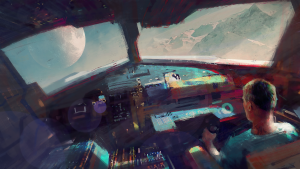 This week, we’re giving you a look at the meta-structure of the Alternity product line. We want Alternity to be the Sci-Fi RPG that lets you choose your own future, and by that, we mean that we want you to be able to implement whichever genre of Sci-Fi that fits your interest. How do we achieve that? Part of the answer is addressing campaign tech levels, but another element we refer to as Modular Design. Here’s Dave to tell you more:
This week, we’re giving you a look at the meta-structure of the Alternity product line. We want Alternity to be the Sci-Fi RPG that lets you choose your own future, and by that, we mean that we want you to be able to implement whichever genre of Sci-Fi that fits your interest. How do we achieve that? Part of the answer is addressing campaign tech levels, but another element we refer to as Modular Design. Here’s Dave to tell you more:
Modular Design in Alternity
Our approach to what we call “modular design” started with a simple precept:
Han Solo never decides, “Should I get better with my blaster, or should I get better at flying the Falcon?”
In other words, forcing a character to split effectiveness between two entirely different realms of endeavor is messy. It’s dissatisfying for the player, because that character is weak in both realms compared to a more-focused counterpart. No one likes to be relegated to second-banana status.
It’s also tough on the encounter designer (whether that’s us Sasquatches or you as the GM) because an encounter in one realm — say a starship dogfight — might be too hard or too easy depending on the assumptions you made about character effectiveness.
Those problems evaporate, of course, in encounters that demand effectiveness in both realms. Those encounters are great… but they’re also difficult to design, and I’m not sure you can string together an effective narrative where every single encounter is (to extend the example) a simultaneous space battle/ground battle.
Many RPGs — and we’ll include the games we Sasquatches have designed in this category — have struggled with this issue. Entirely skill-based systems routinely force that “blaster or Falcon” decision on the player. Even games where the blaster stuff obeys different rules than the Falcon stuff… well, they typically have feats or class features that force the choice.
Benefits from Every Module
For Alternity, we’re building our rules in discrete modules, and your character is fully effective in every module your game is using. In other words, when you make a character and level up, you gain full benefits in the game’s core (which covers ground combat, basic tech interactions, and simple interpersonal stuff) and in any modules you’re using.
 Rolling up a wisecracking space-smuggler? You’ll pick up all the blaster-shooting and fast-talking you need from Alternity’s core. Then you’ll go to the starship module and get the piloting, gunnery, and improvisational repair skills you need to keep that tramp freighter flying.
Rolling up a wisecracking space-smuggler? You’ll pick up all the blaster-shooting and fast-talking you need from Alternity’s core. Then you’ll go to the starship module and get the piloting, gunnery, and improvisational repair skills you need to keep that tramp freighter flying.
One nice side effect of the modular approach is that the starship rules are walled off in their own module, so if you’re playing a post-apocalyptic game or a near-future spy thriller, you never even see those starship rules and they aren’t cluttering things up at your table.
Another nice side effect: no players sitting on their hands. Alternity assumes competence on the part of its protagonists. If you’re having starship-based encounters, then your character has something useful to do on the starship; you aren’t just a spectator. You’ve got the benefits of that starship module, and you can sit down on the bridge and make something happen.
Building Blocks of a Campaign
Another place where the modular approach shines is that you can combine different modules to give your Alternity campaign a particular feel.
Are the players the rag-tag crew of a small starship, plying their trade at the fringes of the frontier and staying one step ahead of the law? Core plus a starships module.
Something cyberpunk like Neuromancer? Core plus a virtual-reality module plus a cyberware module.
Gonzo postapocalyptic? Core plus a mutation module plus a jury-rigging/customize-your-dune-buggy module (which we’ll have a better name for).
Are you a starship trooper? (book not movie, thankyouverymuch) Core plus power armor module.
Lensman or Jedi? Core plus mental powers module, and maybe starships too.
Wanna be a Time Lord? Core plus some sort of timey-wimey module and maybe a more detailed social-interaction module.
We figure most campaigns will use the core rules plus one or two modules, but you could go nuts and add more if you wanted. Because encounters are generally grounded in only one or two modules, characters don’t get more powerful by adding more modules to the campaign. (More broadly effective, sure, but not better in a discrete situation.)
So What Modules Does Alternity Have?
That’s a heck of a good question. We’re hip-deep in design for the game’s core right now. You can definitely count on a starship module and a vehicles module. Those might wind up being the same module, and we might divide between capital-size ships (think Enterprise) and smaller ships (think Serenity).
Beyond that, it’s a question of what Alternity players want to see first, and what we’ve got the bandwidth and other resources to design. And what’s in the main Alternity book as opposed to a book of its own? Undecided at this point.
Got a module you want to see? Let us know! Leave comments on our Facebook posts, or tweet @Sasquatch_Games. The beauty of this point in the project is that our scope is quite broad, and we’re champing at the bit to dig in on module design.

